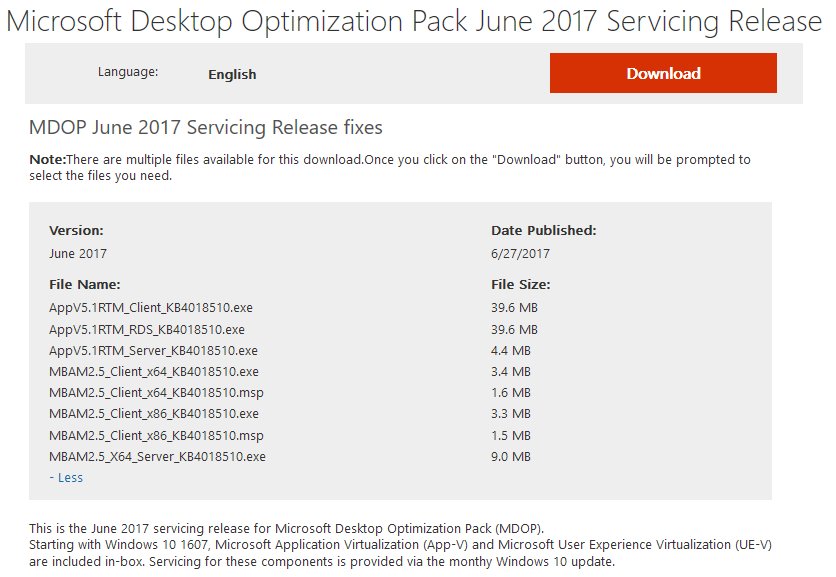- Itunes Download For Windows 10
- Download Mdop For Windows 10 Iso
- Download Mdop For Windows 10 64-bit
- Download Mdop For Windows 10 Activator
- Download Mdop For Windows 10 Kmspico
The Microsoft Desktop Optimization Pack (MDOP) is a portfolio of technologies available as a subscription for Software Assurance customers. MDOP helps to improve compatibility and management, reduce support costs, improve asset management, and improve policy control.
The MDOP Information Experience provides product documentation, videos, blogs, and other resources to help users implement and optimize their experience with the MDOP technologies. You can learn about updates and events by following us on Facebook or Twitter.
MDOP Documentation Links
The following table provides links to the product documentation for the MDOP products by version.
Microsoft Advanced Group Policy Management (AGPM) extends the capabilities of the Group Policy Management Console (GPMC) to provide change control and improved management. AGPM 4.0 SP3 – Windows 10, Windows 8.1, Windows 8, Windows 7, Windows Vista SP1, Windows Server 2012, Windows Server 2012 R2, Windows Server 2008, Windows Server 2008 R2 AGPM 4.0 SP2 - Windows 8.1, Windows 8, Windows 7, Windows Vista SP1, Windows Server 2012, Windows Server 2008, Windows Server 2008 R2 AGPM 4.0 SP1 - Windows 8, Windows 7, Windows Vista SP1, Windows Server 2012, Windows Server 2008, Windows Server 2008 R2 AGPM 4.0 - Windows Vista SP1, Windows 7, Windows Server 2008, Windows Server 2008 R2 AGPM 3.0- Windows Vista SP1, Windows Server 2008 AGPM 2.5 - Windows Vista, Windows Server 2003 | AGPM 4.0 SP1 (https://go.microsoft.com/fwlink/p/?LinkId=286715) |
Microsoft Application Virtualization (App-V) lets you make applications available to end user computers without installing the applications directly on those computers. | App-V 5.0 eBooks (https://go.microsoft.com/fwlink/p/?LinkId=309570) |
Microsoft BitLocker Administration and Monitoring (MBAM) provides an administrative interface to enterprise-wide BitLocker drive encryption. | MBAM Whitepapers on the Microsoft Download Center (https://go.microsoft.com/fwlink/p/?LinkId=231905) MBAM 1.0 eBooks (https://go.microsoft.com/fwlink/p/?LinkId=309571) |
Microsoft Diagnostics and Recovery Toolset (DaRT) helps troubleshoot and repair Windows-based computers. DaRT 10 - Windows 10 DaRT 8.1 - Windows 8.1, Windows Server 2012 R2 DaRT 8.0 SP1 - Windows 8, Windows Server 2012 DaRT 8.0 - Windows 8, Windows Server 2012 DaRT 7.0 - Windows 7, Windows Server 2008 R2 DaRT 6.5 - Windows 7, Windows Server 2008 R2 DaRT 6.0 - Windows Vista, Windows Server 2008 DaRT 5.0 - Windows 2000, Windows XP, Windows Server 2003 | DaRT 6.5 (https://go.microsoft.com/fwlink/p/?LinkId=232983) DaRT Whitepapers on the Microsoft Download Center (https://go.microsoft.com/fwlink/p/?LinkId=232274) DaRT 8.0 eBook (https://go.microsoft.com/fwlink/p/?LinkId=309573) DaRT 7.0 eBook (https://go.microsoft.com/fwlink/p/?LinkId=309572) |
Microsoft Desktop Enterprise Monitoring (DEM) monitors and reports enterprise-wide desktop application and system failures. | DEM 3.5 (https://go.microsoft.com/fwlink/p/?LinkId=232985) DEM Whitepapers on the Microsoft Download Center (https://go.microsoft.com/fwlink/p/?LinkId=232276) |
Microsoft Enterprise Desktop Virtualization (MED-V) uses Microsoft Virtual PC to provide an enterprise solution for desktop virtualization. MED-V 2.0 - Windows 7 MED-V 1.0 SP1 - Windows 7, Windows Vista, Windows XP MED-V 1.0 - Windows Vista, Windows XP | |
Microsoft User Experience Virtualization (UE-V) captures settings to apply to computers accessed by the user including desktop computers, laptop computers, and VDI sessions. | UE-V 1.0 eBooks (https://go.microsoft.com/fwlink/p/?LinkId=309574) |
Itunes Download For Windows 10
Supplemental MDOP Product Guidance
In addition to the product documentation available online, supplemental product guidance such as informational videos and virtual labs are available for most MDOP products.
Microsoft Desktop Optimization Pack (MDOP) is a suite of utilities for Microsoft Windows customers who have subscribed to Microsoft Software Assurance program. It aims at bringing easier manageability and monitoring of enterprise desktops, emergency recovery, desktop virtualization and application virtualization. Secure network customers who want to deploy and manage encrypted Windows 10, who don't use Azure and seemingly can't use MDOP MBAM with modern versions of Windows 10 due to lack of support for say 1809 etc.
MDOP Virtual Labs | For a list of available MDOP virtual labs, go to Microsoft Desktop Optimization Pack (MDOP) Virtual Labs (https://go.microsoft.com/fwlink/p/?LinkId=234276). |
MDOP TechCenter | For technical whitepapers, evaluation materials, blogs, and additional MDOP resources, go to MDOP TechCenter (https://go.microsoft.com/fwlink/p/?LinkId=225286) |
MDOP Forums | Join in the MDOP community where you can ask and answer questions at the MDOP TechNet Forum (https://go.microsoft.com/fwlink/p/?LinkId=286973). |
How to Get MDOP
MDOP is a suite of products that can help streamline desktop deployment, management, and support across the enterprise. MDOP is available as an additional subscription for Software Assurance customers.
Download MDOPMDOP subscribers can download the software at the Microsoft Volume Licensing website (MVLS).
Purchase MDOPVisit the enterprise Purchase Windows Enterprise Licensing website to find out how to purchase MDOP for your business.
-->Applies to
- Windows 10
There are specific infrastructure requirements to deploy and manage Windows 10 that should be in place prior to significant Windows 10 deployments within your organization.
High-level requirements
For initial Windows 10 deployments, as well as subsequent Windows 10 upgrades, ensure that sufficient disk space is available for distribution of the Windows 10 installation files (about 3 GB for Windows 10 x64 images, slightly smaller for x86). Also, be sure to take into account the network impact of moving these large images to each PC; you may need to leverage local server storage.
For persistent VDI environments, carefully consider the I/O impact from upgrading large numbers of PCs in a short period of time. Ensure that upgrades are performed in smaller numbers, or during off-peak time periods. (For pooled VDI environments, a better approach is to replace the base image with a new version.)
Deployment tools
The latest version of the Windows Assessment and Deployment Toolkit (ADK) is available for download here.
Significant enhancements in the ADK for Windows 10 include new runtime provisioning capabilities, which leverage the Windows Imaging and Configuration Designer (Windows ICD), as well as updated versions of existing deployment tools (DISM, USMT, Windows PE, and more).
The latest version of the Microsoft Deployment Toolkit (MDT) is available for download here.

For Configuration Manager, Windows 10 version specific support is offered with various releases.
For more details about Microsoft Endpoint Manager support for Windows 10, see Prepare for Zero Touch Installation of Windows 10 with Configuration Manager.
Management tools
In addition to Microsoft Endpoint Configuration Manager, Windows 10 also leverages other tools for management. For Windows Server and Active Directory, existing supported versions are fully supported for Windows 10. New Group Policy templates will be needed to configure new settings available in Windows 10; these templates are available in the Windows 10 media images, and are available as a separate download here. See Group Policy settings reference for a list of the new and modified policy settings. If you are using a central policy store, follow the steps outlined here to update the ADMX files stored in that central store.
No new Active Directory schema updates or specific functional levels are currently required for core Windows 10 product functionality, although subsequent upgrades could require these to support new features.
Microsoft Desktop Optimization Pack (MDOP) has been updated to support Windows 10. The minimum versions required to support Windows 10 are as follows:
| Product | Required version |
|---|---|
| Advanced Group Policy Management (AGPM) | AGPM 4.0 Service Pack 3 |
| Application Virtualization (App-V) | App-V 5.1 |
| Diagnostics and Recovery Toolkit (DaRT) | DaRT 10 |
| Microsoft BitLocker Administration and Monitoring (MBAM) | MBAM 2.5 SP1 (2.5 is OK) |
| User Experience Virtualization (UE-V) | UE-V 2.1 SP1 |
For more information, see the MDOP TechCenter.
For devices you manage with mobile device management (MDM) solutions such as Microsoft Intune, existing capabilities (provided initially in Windows 8.1) are fully supported in Windows 10; new Windows 10 MDM settings and capabilities will require updates to the MDM services. See Mobile device management for more information.
Windows Server Update Services (WSUS) requires some additional configuration to receive updates for Windows 10. Use the Windows Server Update Services admin tool and follow these instructions:
- Select the Options node, and then click Products and Classifications.
- In the Products tree, select the Windows 10 and Windows 10 LTSB products and any other Windows 10-related items that you want. Click OK.
- From the Synchronizations node, right-click and choose Synchronize Now.
WSUS product list with Windows 10 choices
Because Windows 10 updates are cumulative in nature, each month’s new update will supersede the previous month's. Consider leveraging “express installation” packages to reduce the size of the payload that needs to be sent to each PC each month; see Express installation files for more information. (Note that this will increase the amount of disk storage needed by WSUS, and impacts all operating systems being managed with WSUS.)
Activation
Windows 10 volume license editions of Windows 10 will continue to support all existing activation methods (KMS, MAK, and AD-based activation). An update will be required for existing KMS servers:
| Product | Required update |
|---|---|
| Windows 10 | None |
| Windows Server 2012 R2 and Windows 8.1 | https://support.microsoft.com/kb/3058168 |
| Windows Server 2012 and Windows 8 | https://support.microsoft.com/kb/3058168 |
| Windows Server 2008 R2 and Windows 7 | https://support.microsoft.com/kb/3079821 |
Also see: Windows Server 2016 Volume Activation Tips
Download Mdop For Windows 10 Iso
Additionally, new product keys will be needed for all types of volume license activation (KMS, MAK, and AD-based Activation); these keys are available on the Volume Licensing Service Center (VLSC) for customers with rights to the Windows 10 operating system. To find the needed keys:
Download Mdop For Windows 10 64-bit
- Sign into the Volume Licensing Service Center (VLSC) at with a Microsoft account that has appropriate rights.
- For KMS keys, click Licenses and then select Relationship Summary. Click the appropriate active license ID, and then select Product Keys near the right side of the page. For KMS running on Windows Server, find the Windows Srv 2012R2 DataCtr/Std KMS for Windows 10 product key; for KMS running on client operating systems, find the Windows 10 product key.
- For MAK keys, click Downloads and Keys, and then filter the list by using Windows 10 as a product. Click the Key link next to an appropriate list entry (for example, Windows 10 Enterprise or Windows 10 Enterprise LTSB) to view the available MAK keys. (You can also find keys for KMS running on Windows 10 in this list. These keys will not work on Windows servers running KMS.)
Note that Windows 10 Enterprise and Windows 10 Enterprise LTSC installations use different MAK keys. But you can use the same KMS server or Active Directory-based activation environment for both; the KMS keys obtained from the Volume Licensing Service Center will work with both.
Download Mdop For Windows 10 Activator

Related topics
Download Mdop For Windows 10 Kmspico
Windows 10 servicing options
Windows 10 deployment considerations
Windows 10 compatibility